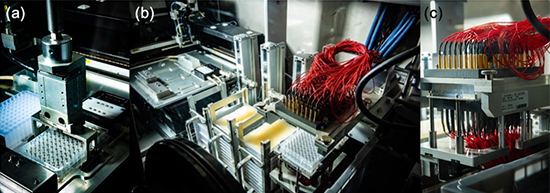Data-driven robotic experiments accelerate discovery of multi-component electrolyte
2022.03.23
National Institute for Materials Science (NIMS)
Japan Science and Technology Agency (JST)
A NIMS research team has developed a new method of identifying electrolyte materials with desirable property by combining an automated robotic experiment system and data scientific techniques.
Abstract
- A NIMS research team has developed a new method of identifying electrolyte materials with desirable property by combining an automated robotic experiment system and data scientific techniques. Using developed method, the team succeeded in discovery of multi-component electrolyte that enhance the cycle life of lithium–air batteries. This method accelerates the development of next-generation rechargeable batteries.
- Rechargeable batteries are indispensable in today’s society. They are now used in an expanding range of applications, including automobiles and smart grids. Because the performance of currently available lithium-ion batteries is approaching their theoretical limit, new rechargeable batteries urgently need to be developed. A rechargeable lithium–air battery is promising candidate for next-generation rechargeable batteries due to their high energy density, which is more than two to five times higher than that of lithium-ion batteries. However, the limited cycle life needs to be overcome for the practical implementation of lithium–air batteries. For improvement of the cycle life, the development of electrolyte material is crucial. In particular, the electrolyte should be stable in both oxygen positive electrode and lithium negative electrode. The ideal electrolyte composition has been investigated based on trial-and-error approach based on researchers’ experience and intuition. However, there are numerous number of candidate for electrolyte, which is composed by various kinds of chemicals with wide range of concentration. Thus, it is difficult to efficiently identify the ideal electrolyte composition that maximizes the performance of battery. For accelerating the research development of rechargeable lithium–air battery, the new method for searching the electrolyte material is highly demanded.
- This research team had previously developed a robotic system capable of automatically preparing electrolytes with different compositions and evaluating their performance more than 100 times faster than is possible manually. In this project, the team developed a new, efficient method for searching the ideal electrolyte composition by combining the robotic system and data scientific techniques. The robotic system was used to generate a large amount of experimental data, which was then analyzed using data scientific techniques, including Bayesian optimization. After investigation more than 10,000 kinds of candidate electrolyte, the research team finally discover the specific combination of electrolyte that enables extending the cycle life of lithium-air batteries.
- The method demonstrated in the present study also can be applicable to various types of rechargeable batteries in addition to lithium–air batteries. Thus, the developed method is effective for accelerating the development of next-generation rechargeable batteries.
- This project was carried out by a research team led by Shoichi Matsuda (Senior Researcher, NIMS), Guillaume Lambard (Senior Researcher, NIMS) and Keitaro Sodeyama (Group Leader, NIMS). This work was conducted in conjunction with other R&D projects supported by the JST’s ALCA-SPRING and COI-NEXT programs.
- This research was published in Cell Reports Physical Science, an open access journal, at 12:00 am on March 23, 2022, Japan Time.

Firgure. Robotic system capable of automatically evaluating the electrochemical properties of a large number of electrolytes. (a) Electrolyte preparation section in which electrolytes with different compositions are automatically prepared in a multiwell plate. The robotic arm then transfers the plate to the electrode section. (b) Entire robotic system. (c) Electrode section where a multiwell plate containing electrolyte samples is sandwiched between the top and bottom electrodes, allowing simultaneous evaluation of them.
Related files
- Center for Green Research on Energy and Environmental Materials
Contact information
(Regarding this research)
-
Shoichi Matsuda
Senior Researcher
Rechargeable Battery Materials Group,
Center for Green Research on Energy and Environmental Materials
National Institute for Materials Science
Tel: +81-29-860-4637
E-Mail: MATSUDA.Shoichi=nims.go.jp
(Please change "=" to "@")
(Regarding JST programs)
-
Shinichi Kato
Department of R&D for Future Creation
Japan Science and Technology Agency
K's Gobancho, 7 Gobancho, Chiyoda-ku, Tokyo 102-0076, Japan
Tel: +81-3-3512-3543
Fax: +81-3-3512-3533
E-Mail: alca=jst.go.jp
(Please change "=" to "@")
(General information)
-
Public Relations Office
National Institute for Materials Science
Tel: +81-29-859-2026
Fax: +81-29-859-2017
E-Mail: pressrelease=ml.nims.go.jp
(Please change "=" to "@") -
Public Relations Division
Japan Science and Technology Agency
5-3 Yonbancho, Chiyoda-ku, Tokyo 102-8666, Japan
Tel: +81-3-5214-8404
Fax: +81-3-5214-8432
E-Mail: jstkoho=jst.go.jp
(Please change "=" to "@")
Same Keywords
-
Extending the Life of a Lithium Metal Anode Using a Protective Layer Made of an Extremely Tough Gel Electrolyte
(electrolyte)
2023.04.19
-
Chemical Crossover Accelerates Degradation of Lithium Electrode in High Energy Density Rechargeable Lithium–Oxygen Batteries
(cycle life)
2023.01.31
-
Identification of a Major Factor Influencing the Cycle Life of Practical Li-O2 Batteries
(cycle life)
2020.12.02
Recent Press Release
-
Simultaneous Imaging of Intracellular DNA and RNA Using Harmless Light
2025.10.27
-
Development of an AI Device Using Ion Gel and Graphene That Dramatically Streamlines Machine Learning Computations
2025.10.14
-
Demonstrating a Novel Method to Modulate Heat Flow Through the Collective Motion of Spins
2025.10.06
